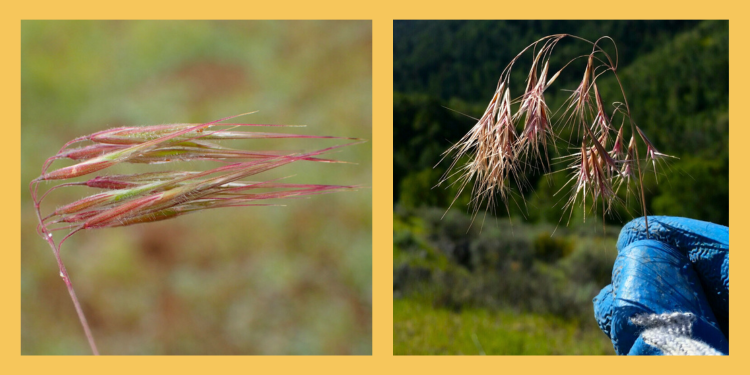Challenging Cheatgrass
By Michela Gentile, Science Communication Specialist, Golden Gate National Parks Conservancy
Pictured above: Cheatgrass (Bromus tectorum). Photos: Sadie Hickey/Parks Conservancy (right) and David Greenberger (left), via iNaturalist and shared under CC BY NC.
One Tam’s Conservation Management Team has some exciting success to share from this season’s early detection rapid response program (EDRR) for managing weeds. EDRR means finding patches of high-priority weeds and removing them before they can harm an ecosystem.
Since 2016, we’ve been monitoring for and removing cheatgrass (Bromus tectorum). While not widespread in the Mt. Tam region, it’s a high priority weed to watch because of its impact throughout the western U.S., where it outcompetes native vegetation and can alter fire behavior.
Cheatgrass is a challenge: it can be difficult to identify before it flowers, its seeds spread easily, and in warmer temperatures it goes to seed rapidly (shortening the window for effective treatment). What’s more, according to our 2020 EDRR report, “On Mt. Tamalpais this annual grass grows primarily on gravelly, disturbed soils—including rare serpentine barren habitat.” To give these and other sensitive habitats the best chance to thrive, we have to look for weeds like cheatgrass.
The team has now completed our 2024 monitoring for cheatgrass, and found that only two of the nine sites that we cover had cheatgrass present, and both contained less than last year. In total, we found just 22 individual plants among these two sites this year, down from 10,000+ when patches were first detected in the area.
We’ll still be on the lookout for cheatgrass into the future, not least because it remains a challenge in nearby areas. But there is no greater testament to the efficacy of this work than such a reduction in a priority weed across those patches.



